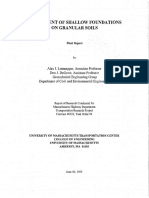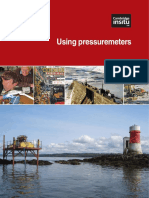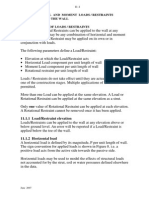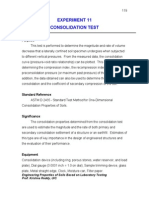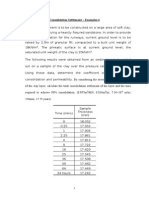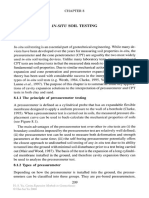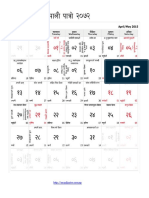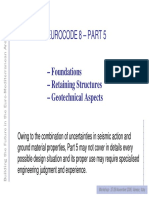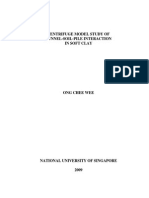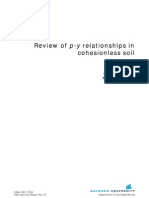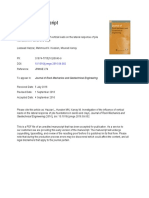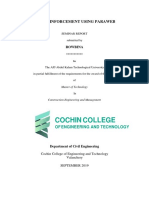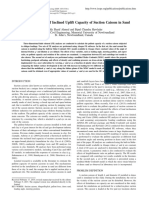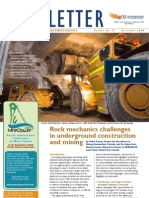Pressuremeter Test
Pressuremeter Test
Uploaded by
Sudeep SharmaCopyright:
Available Formats
Pressuremeter Test
Pressuremeter Test
Uploaded by
Sudeep SharmaOriginal Description:
Copyright
Available Formats
Share this document
Did you find this document useful?
Is this content inappropriate?
Copyright:
Available Formats
Pressuremeter Test
Pressuremeter Test
Uploaded by
Sudeep SharmaCopyright:
Available Formats
CHAPTER 2
PRESSUREMETERS IN GEOTECHNICAL ENGINEERING
2.1
INTRODUCTION
Geotechnical engineering relies, in most of the cases, on empirical observations and experience. One of the main reasons for relying upon observed results is that there are practical restrictions involved in extracting quality soil samples and performing laboratory testing. Another reason for the continued reliance on the observed results is the inability to obtain exact and repeatable strength properties of soil and rock at a reasonable cost. In order to solve these issues, geotechnical engineers have been trying to develop the in-situ testing procedures. The main limitation to the in-situ testing is the selection of an appropriate device that can provide reliable engineering parameters with least disturbance to soil. Over the last half century, a lot of research has been carried out towards developing new in-situ soil testing devices and data analysis procedures around the world. These devices include cone penetrometers, pressuremeters, dilatometers etc. have been developed with the aim to obtain better quality soil parameters. This chapter presents state-of-the-art literature available on the various types of pressuremeters, data analyses, interpretation and applications in geotechnical engineering. 2.2 DEFINITION OF A PRESSUREMETER
A pressuremeter is basically a cylindrical probe with an expandable flexible membrane. A uniform hydraulic or gas pressure can be applied to the walls of the test pocket through the membrane to get the ground response curve, viz., applied pressure versus expansion of the membrane. The ground response curve can be interpreted to obtain fundamental soil properties and design parameters, such as strength, stiffness and in-situ horizontal stress. Figure 2.1 describes the definition of a pressuremeter. The probe is lowered to the test depth with drill or cone rods. The test section of the probe is connected with a cable to the control unit at the surface. This control unit includes a pressure supply regulator and a data logger. The pressuremeter test is the only test that can give directly values of in-situ horizontal stress, stiffness and strength (Clarke, 1996).
15
CHAPTER 2
PRESSUREMETERS IN GEOTECHNICAL ENGINEERING
Control cable/hose Drill rod Test control
Data logger
Probe lowered into test pocket (a)
Borehole
Guard cell Test section Guard cell
Test module
(b)
Probe
Test section Test pocket Test pocket larger diameter than probe
Figure 2.1 The definition of a pressuremeter
Figure 2.2 Types of prebored pressuremeters (a) a tricell probe (b) a monocell Probe pushed into test pocket
Probe drilled into test pocket
Test pocket same diameter as probe
Test pocket larger diameter than probe due to friction reducer
Friction reducer
Self-boring head
External cone for full displacement
Figure 2.3 Self-boring pressuremeter
Figure 2.4 Full-displacement pressuremeter 16
CHAPTER 2
PRESSUREMETERS IN GEOTECHNICAL ENGINEERING
2.3
HISTORY OF THE PRESSUREMETER
The roots of the pressuremeter extend back to Kogler, who developed the first preboring pressuremeter in Germany in 1933. Owing to the limitations of the available materials, Kogler could achieve only partial success. However, Louis Mnard, a French engineer, made significant advances in the pressuremeter device, its analysis and its acceptance. Therefore, Mnard is referred to as the father of the pressuremeters. The pressuremeter, he developed was patented in 1955. Since then there have been many advances; not only in the development of the equipment but also in the analysis of results, as described in the following articles. 2.4 TYPES OF PRESSUREMETERS
Pressuremeter probes are grouped on the bases of their method of installation (pre bored, self-bored or pushed in) and method of measuring displacement (volume or radial). Based on their method of installation, pressuremeters can be divided into following different types: (i) Pre-bored pressuremeter (PBPM) This pressuremeter is lowered into the pre-bored test pocket and test is performed. This PMT requires test pocket diameter slightly greater than the diameter of the probe. If a stable test pocket can be drilled, any ground condition can be tested using this pressuremeter. PBPMs are the most common group of pressuremeters and their versions have been in commercial use since 1958. The expansion of the membrane can be monitored at the surface using either displacement transducer(s) (radial displacement type) or volume change transducers (volume displacement type). The original Mnard pressuremeter is a volume displacement type tricell probe (Figure 2.2a). The central cell is allowed to expand while the outer cells, also called guard cells, are provided to ensure the true cylindrical expansion of the central cell. In the 1950s, the OYO Corporation of Japan developed a single-cell or monocell in which expansion was measured through displacement transducers (Figure 2.2b).
17
CHAPTER 2
PRESSUREMETERS IN GEOTECHNICAL ENGINEERING
(ii) Self-boring pressuremeter (SBPM) A self-boring pressuremeter (SPBM) creates its own test pocket in the ground. The probe of this pressuremeter is headed by a sharp rotating cutter shoe, which removes enough soil to accommodate the volume of the pressuremeter. During boring the instrument is pushed slowly into the ground. The pushing is halted when the centre of the membrane reaches the test level. These probes can be used in any soil provided the gravel content is small, and in some weak rocks (Clarke, 1996). The SBPMs were developed both in France (Jzquel et al., 1968) and in the UK (Wroth & Hughes, 1973). Both probes have a single-cell but use different expansion measurement systems. The French SBPM has a volume measuring system, while the UK probe uses displacement transducers. Figure 2.3 describes the principle of this SBPM. (iii) Pushed-in pressuremeter (PIPM) This pressuremeter (PIPM) is pushed into a soil, thus creating a disturbed zone around the pocket during installation and can only be used in soils in which it is possible to push a static-cone penetrometer. Reid et al. (1982) developed the first PIPM developed primarily for offshore use. In 1988, Huang et al. developed another PIPM for on land use. In both cases, a thick walled tube is pushed into the soil. The displaced soil enters the tube and is withdrawn with it after the test. The membrane is inflated by oil and the measurement of pressure and the volumetric strains are made. (iv) Full-displacement pressuremeter (FDPM) The idea of mounting a pressuremeter probe behind a cone penetrometer to enable tests to be performed as a part of the cone penetration test operations was initiated in the early 1980s in both France and Canada. However, these devices being large in diameter required special equipment for their installation and were superceded by devices of smaller diameter. The membrane is protected by a Chinese lantern. A friction reducer is used to reduce the shear between the soil and the probe. This implies that at the start of a test the membrane may not be in contact with the ground. The first pressuremeter of this type was developed by Withers et al. (1986). It is headed by a 15 cm2 solid cone, which is pushed into place by displacing the ground, as shown in Figure 2.4. It measures the inflation pressure and the circumferential strain at three 18
CHAPTER 2
PRESSUREMETERS IN GEOTECHNICAL ENGINEERING
locations 120 apart at the centre of the membrane. The instrument is inflated by Nitrogen gas or oil when used for offshore operations (Withers et al. 1986). The latest Fugro device (Zuidberg & Post, 1995) has been further simplified for easier assembly and better control of the tests but the basic design has remained unchanged. Based on the method of installation, the FDPM can be grouped with pushed-in pressuremeters. Apart from the Mnard pressuremeter, modern pressuremeters are single-cell and have either a volume or radial displacement measuring system. Table 2.1 presents details of commercially available pressuremeters in the UK indicating the group to which they belong, their displacement measuring system and the ground in which they can operate. 2.5 SELECTION OF A PRESSUREMETER
The selection of a pressuremeter mainly depends on the condition of ground under investigation and the required design parameters. Figure 2.5 provides guiding principles for selecting a suitable type of pressuremeter based on these factors. 2.6 MERITS AND LIMITATIONS OF PRESSUREMETERS
Every equipment has certain merits and limitations when used for the determination of the desired parameters. Likewise pressuremeters also have some merits and limitations. Some of the merits and limitations are given below (Akbar, 2001): Merits
Any ground condition can be tested provided an appropriate type of pressuremeter is
used.
The similarity between the expansion of the pressuremeter membrane and that of a
cylindrical cavity allows the use of available close form solutions for the determination of pressuremeter parameters.
The basic soil parameters, such as shear modulus, non-linear stiffness profile, total
horizontal stress and undrained shear strength for clays or angle of internal friction for sands, can be determined by pressuremeters.
The pressuremeter can also provide design parameters directly (Mnard test).
19
CHAPTER 2
PRESSUREMETERS IN GEOTECHNICAL ENGINEERING
Table 2.1 Some details of commercially available pressuremeters in the UK (From Clarke, 1996) Group Prebored Name Mnard pressuremeter GC Mnard pressuremeter GB Oyo Elastometer 100 Oyo Elastometer 200 High pressure dilatometer Self-bored Cambridge self-boring pressuremeter Weak rock self-boring pressuremeter Pushed-in Cone pressuremeter Pressure capacity MPa 4 20 10 20 20 4.5 20 4.5 25 15 10 50 Strain capacity % 53 53 12 Diameter mm 74 74 66 66 73 84 73 44 1.5 1 1 1 520 520 455 500 400 450 Total length m Expanding length mm L/D 6.5 6.5 7.4 7.4 6.1 6 5.5 10.3 Displacement measurement system volume volume Ground conditions All soils
Weak to moderately strong rocks one diameter Stiff clays, dense sands and weak rocks one diameter Weak to moderately strong rocks three diameters Weak to moderately strong rocks three radii All soil containing little or no gravel three radii Hard clays, very dense sands and weak rocks three radii All soil amenable to static cone penetrometer testing
20
CHAPTER 2
PRESSUREMETERS IN GEOTECHNICAL ENGINEERING
Pressuremeter Probe Pressure capacity Ground conditions Pre-bored low to medium all soils high rock Self-bored low to medium soils containing little or no high weak rock Pushed-in low to medium soils in which a cone can be pushed
Test type
Mnard design parameters Em, pL
stress/strain
stress/strain stress-strain curve
stress/strain
Parameters
h by iteration from loading
strength from limit pressure and unloading curve
strength from loading curve
h directly
Gur from unload/reload cycle
strength from unloading curve and correlations
h from correlations and unloading curv
Figure 2.5 Guidelines for the selection of a pressuremeter (From Clarke, 1996) 21
CHAPTER 2
RESSUREMETERS IN GEOTECHNICAL ENGINEERING
These devices can be used as ground profiling tools, as a control test for ground
improvement and to calibrate other devices. Limitations
The pre-boring technique influences the soil properties adjacent to the test pocket. This
technique may not be used in soils where the chances of borehole collapse are present. Repeatable results are difficult to produce using the PBPM. Careful control of the procedure can produce repeatable results; however, application of the data is usually empirically based (Withers et al., 1986).
The SBPM was developed with the aim to minimise ground disturbance. This instrument
provides soil properties of high quality; however, a lot of skill and experience is needed for the operation of the SBPM. Moreover SBPMs cannot be used in difficult ground conditions such as soils containing gravels and hard rocks.
The cross-sectional area of the PIPMs requires a large reaction force for pushing in
cemented soils, hard clays and dense sands. The design of the tube of the PIPMs does not allow their use in all types of soils and the boundary conditions at the start of the test can vary (Withers et al., 1986).
The FDPM is a relatively small pressuremeter, produces repeatable disturbance and is
operator independent. Owing to same diameters (43.7 mm) of the pressuremeter and the cone, the rubber membrane experiences ground friction during pushing of instrument into the ground. This friction force between the membrane and the ground can damage the membrane or can pull the membrane out of the contracting ring. The membrane therefore requires some sort of protection such as Chinese lantern. 2.7 THE SUITABILITY OF PRESSUREMETERS TO GROUND CONDITIONS
Table 2.2 gives a summary of the suitability of pressuremeters in various ground conditions. PBPMs can be used in any type of soil or rock in which the borehole remains stable with or without mud. SBPMs are applicable in grounds having little or no gravels and in weak rocks. PIPMs and FDPMs can be used in grounds where it is possible to push a cone. It means dense sands, hard clays, gravely soils and rocks are not suitable for cone pressuremeters. Since the probe supports the test pocket wall during installation, the test pocket wall stability
22
CHAPTER 2
RESSUREMETERS IN GEOTECHNICAL ENGINEERING
is not critical in case of SBPMs and FDPMs. However, care is required for ensuring the stability of a borehole. Table 2.2 The applicability of pressuremeters to ground conditions (From Clarke, 1995) Ground type Soft clays Stiff clays Loose sands Dense sands Gravels Weak rock Strong rock PBPM A A B with support B with support C by driving A A SBPM A A A B N B N PIPM A A A C N N N
A: very good; B: good; C: moderate; N: not possible 2.8 CALIBRATIONS In order to convert pressuremeter test data to applied pressure and strain and to correct for system or membrane compliance, different types of calibrations are carried out. Table 2.3 presents the recommended frequency and relevance of the calibrations for the three groups of pressuremeters (Clarke, 1996). The calibrations of displacement and pressure transducers are carried out in laboratory by comparing their voltage output with measured values of displacement and pressure respectively. All radial displacement type probes contain transducers. Any hysteresis and non-linearity for the transducers is checked during calibration to establish a confidence level on the accuracy of the test results. The membrane stiffness is obtained by inflating the probe in air. The pressure required to inflate a membrane in air is referred to as the membrane stiffness. The membrane stiffness is deducted from the applied pressure during a test in order to obtain the correct pressure at the membrane/soil interface. This calibration applies to all pressuremeter tests and is carried out whenever a membrane is replaced.
23
CHAPTER 2
RESSUREMETERS IN GEOTECHNICAL ENGINEERING
Table 2.3 Frequency and relevance of calibrations (From Clarke, 1996)
Calibration Pre-bored Volume Transducers if fitted Radial Yes Self-bored and pushed-in yes Frequency Additional calibrations Soft ground Max. pres. 1 MPa critical Relevance Most ground Max. pres. 4 MPa critical Strong ground Max. pres. 20 MPa critical
1. start and finish of project 2. regular intervals during project.
System compliance Membrane stiffness
yes yes
No Yes
no yes
Membrane compression
yes
Yes
yes
1. start and finish of project 2. regular intervals during project. 1. start and finish of project 2. regular intervals during project 3. every time a membrane is replaced. 1. start and finish of project 2. regular intervals during project. 3. every time a membrane is replaced. 1. prior to borehole lowering into
1. any change in the transducers 2. change to the lead connecting the probe to the surface 3. following damage to probe which involves thorough cleaning and drying. 1. change to the lead connecting the probe to the surface. 2. change to the control unit.
important critical
important important
critical not important
unnecessary
not important
critical
Membrane thining Zero
no yes
Yes Yes
yes yes
not important critical
not important critical
critical critical
24
CHAPTER 2
PRESSUREMETERS IN GEOTECHNICAL ENGINEERING
Membrane compression is a change in the thickness of a membrane due to pressure and as it expands. The changes in both cases are small and are only significant for tests in rocks using displacement type probes. Calibration for the membrane thinning is necessary (in rocks) as the transducers measure the movement of the inner surface of the membrane, which is different from that of the outer surface. Calibrations for the system compliance, membrane compression and thinning for volume displacement type probes are carried out by pressurizing the probe in a metal cylinder. It represents the volume change that occurs in the supply line (hose), testing equipment and probe as the pressure is increased. 2.9 INSTALLATION
Installation is the process by which a test pocket is created in order to install a pressuremeter probe and perform the test. Installation technique can considerably affect the shape of a test curve and the quality of the interpreted design parameters. Undoubtedly, the installation technique should be consistent and should be designed in such a manner that either it creates minimum disturbance or produces repeatable disturbance to the surrounding ground. The installation techniques for different types of pressuremeters are discussed below: a) Installation technique for PBPM A pocket for a PBPM can be created using different techniques but the best technique is that which removes all material and minimizes disturbance to the pocket wall (Clarke, 1996). The borehole should be designed according to the size of the pressuremeter to be employed. The design criteria include pocket size, minimum disturbance during drilling and removal of drill rods and drill bit. The probe diameter has to be smaller than the pocket diameter to enable it to be lowered into place (Clarke, 1995). As a guide, the ratio of the diameter of the pocket to that of the probe must not be greater than 1.10 (Mair and Wood, 1987). American Society for Testing and Materials (ASTM) recommends the ratio between 1.03 and 1.20 (Briaud and Gambin, 1984). The borehole can be drilled using either shell and auger techniques or rotary techniques (Clarke, 1996). It is recommended that the probe should be lowered down the hole within 15 minutes of completing the drilling (Mair and Wood, 1987 so that conditions remain undrained.
25
CHAPTER 2
PRESSUREMETERS IN GEOTECHNICAL ENGINEERING
b) Installation technique for SBPM An SBPM pocket is drilled in soft to stiff clay using an internal bit driven by rotating inner rods. Mud is pumped down the inner rods to flush the cuttings back through the annulus between the inner and outer rods to the surface where they are collected in a settling tank. The mud pressure, speed of advance and cutter position are adjusted by the operator to ensure that the SBPM replaces the ground as the probe advances. Although as the stiffness of the clay increases it becomes more economical to use a separate rig to advance the borehole between test locations. A separate rig is always recommended when using an SBPM in sands due to potential borehole collapse (Clarke, 1996). c) Installation technique for FDPM A FDPM is pushed into the ground using a cone truck or a pushing rig or a jack. The ground reaction is achieved by placing ground anchors into the ground for a pushing rig or a purpose built reaction frame for the jack. The reaction force can also be obtained by placing the dead weight on the purpose built reaction frame. The FDPM probe is fixed with the pushing rig or the jack to push it into the soil up to the desired test level. A FDPM can be used in any soil in which it is possible to push a static cone penetrometer without damaging the cone. Some of the points, which should be kept in mind alongwith the previous discussion on installation, are briefly described below:
The minimum test spacing in a borehole should be one meter to ensure that no disturbance is produced to the ground by the previous test above.
It is common to specify tests at particular horizons to obtain a profile of ground parameters. The centre of the expanding section should be at least half a metre plus half the length of the expanding section below the base of the borehole to minimize the effects of the borehole on a test curve.
2.10
The standard pushing rate for a FDPM is 2 cm/s using a standard cone truck. TEST PROCEDURE
A test is defined as the application of pressure to a pocket wall. A pressuremeter test can be performed as either
26
CHAPTER 2
PRESSUREMETERS IN GEOTECHNICAL ENGINEERING
Stress-controlled test or Strain-controlled test
A true stress-controlled test is one in which a pressure increment is maintained for 60 to 120 seconds (Clarke, 1996). All pressuremeter tests are stress-controlled, but it is possible to expand a membrane at an almost constant strain rate with small increments of pressure. This is the procedure mostly employed when testing with an SBPM or a FDPM. The rate of strain is 1%/min. and 5%/min. for the SBPM and the FDPM respectively (Clarke, 1996). The tests, however, remain stress-controlled prior to the on-set of yield, unloading to yield in extension and during an unload-reload cycle. This permits a better control at lift-off and prevents creep effects prior to unload-reload and final unloading (Howie et al., 1990; Clarke, 1996). Tests in rocks and tests using volume displacement type pressuremeter probes tend to be stresscontrolled. The importance of the rate of strain can not be denied during a strain-controlled test as it influences the test results. The undrained shear strength, su increases about 15% for every ten times increase of strain rate for pressuremeter strain path (Penumadu et al. 1988). A high strain rate test can affect the clay strength due to its viscous behaviour, whereas a too slow test can result in partial drainage. The test procedure to be adopted is necessarily a compromise (Houlsby & Withers, 1988). Mnard test is a special stress controlled test used to obtain design properties directly from volume displacement tricell pre-bored probes. The probe is lowered into the prebored pocket and expanded in about ten to fourteen equal stress increments until the volume of the pocket is approximately doubled in size. Each increment is maintained for one minute with readings of volume being recorded at 15 s, 30 s and 1 min after applying the increment. Shear modulus is determined from the unload-reload cycle by restricting it within a stress range so that failure in extension does not occur. For clay, this stress range will typically be equal to its undrained shear strength; while for sand it will be around 40% of the effective pressure at the start of unloading. An unload-reload cycle can be excluded from a test if strength is the only parameter required, as it is determined from the latter part of the loading curve or from the unloading curve.
27
CHAPTER 2
PRESSUREMETERS IN GEOTECHNICAL ENGINEERING
A pressuremeter test is continued to the maximum average cavity strain required which should be less than the strain capacity of the probe. However, a test can be stopped earlier for one of the following reasons (Clarke, 1996): (a) The maximum pressure capacity of the probe is insufficient to yield the ground. This is frequent when rocks are tested. (b) The membrane bursts because of damage caused either during installation, during a test by discontinuities in the ground, or by expansion up into the annulus between the pocket wall and drill rods. (c) The oil capacity runs out because of non-uniform expansion. (d) The test pocket created is too large. 2.11 INTERPRETATION OF PRESSUREMETER DATA
The analyses of the pressuremeter test data can be carried out to determine three main soil parameters: in-situ total horizontal stress, stiffness or shear modulus and strength. Table 2.4 presents different methods for the determination of these parameters. These methods are discussed below. 2.11.1 Horizontal Stress, ho Horizontal stress is defined as the in-situ geostatic stress. Its determination is subjective since it depends on selecting a single point on a test curve. Several methods are available to identify that point but all these techniques are based on assumptions. Figure 2.6 gives the position of the horizontal stress for all the three types of pressuremeters. The available methods include: (a) The lift-off method. (b) Methods based on shear strength. (c) Methods based on test procedure. (d) Fitting functions to the test curve. (e) Empirical correlations with other data.
28
CHAPTER 2
PRESSUREMETERS IN GEOTECHNICAL ENGINEERING
The detailed description of each method can be seen in Clarke (1995). Since ground disturbance is least only in case of SBPM, the horizontal stress can be determined directly from this test. For PBPM and FDPM probes, ho can be determined using the abovementioned methods.
Applied pressure
FDPM test
PBPM test SBPM test h h po
FDPM ao
SBPM ao
PBPM ao
Displacement or volumetric strain
Figure 2.6 Typical curves and positions of the reference datum, ao for the three types of pressuremeters (After Clarke, 1995) Houlsby et al. (1988) have proposed a correlation presented in Table 2.4 to estimate ho for clays using FDPM probe. estimated from the method. Yu et al. (1996) proposed a technique to estimate ho in normally consolidated sands using Jakys expression for the coefficient of earth pressure at rest: Ko = 1-sinps. Table 2.4 gives an equation to evaluate angle of internal friction, which may be used to determine Ko. Using this Ko, the effective horizontal stress (h) can be estimated using the basic correlation h = Ko v , where v is the vertical effective stress. However, they are not sure about the reliability of values
29
CHAPTER 2
PRESSUREMETERS IN GEOTECHNICAL ENGINEERING
Table 2.4 Commonly used methods to interpret pressuremeter tests (From Clarke, 1996)
Soil type All soils and rocks Clay Parameter Gur or Gu or Gr h h h Gu or Gr v c su su su h h Gu or Gr v c ' ' ' Probe All probes PBPM SBPM FDPM All probes PBPM SBPM FDPM PBPM, FDPM SBPM All probes PBPM SBPM FDPM Method Unload-reload cycle Curve fitting Directly from curve Logarithmic model Unloading curve Unload-reload cycle Modified limit pressure Latter part of loading curve Unloading curve Not recommended Directly from curve Unload-reload cycle Not recommended Latter part of loading curve Unloading curve Reference Equation 0.5 (dp/dc)
Marsland and Randolph (1977) Gupta (2000) Houlsby and Withers (1988) Muir Wood (1990) Amar et al. (1975) Windle and Wroth (1977) Houlsby and Withers (1988) Ghionna et al. (1995) Nutt (1993) Bellotti et al. (1989) Mnard Hughes et al. (1977) Schnaid & Houlsby (1992) Houlsby & Nutt (1993) Ghionna et al. (1995) pL = h+su+suln[4I2r/(4Ir-1)] pL su[1+ln(G/su)] (plmh)/(5.5 to 15) (ph) = su[1+ln(G/su)+ln(V/V)] p = pL2su[1+ln{sinh(max)/sinh(su/G)}] Ko = [a (pL-uo)/ 'vo] [(1+2Ko)/3]b/[(qc-uo)/ 'vo]b (pLh)/'h = 1.98 + 19.1Dr
Sand
plm = b 2('24)/4 b = 1.8 for wet and 3.5 for dry sand and 2.5 on average sin' = s/[1+(s-1)sin'cv] ' = 1.45[(qch)/( 'h)]+26.5 Dr = 1/3 [(qch)/('h)]+10 (pLh)/'h = 2.21 + 19.35Dr (qch)/(pLh) = 3.80 + 9.84Dr 'tc = 33.4 50.78o ps = [14.7/ln(G/'vo)]*(q'c/pL) +22.7 sin = s+(s1)sin'cv
SBPM Latter part of loading curve For definition of symbols, refer to the list of symbols.
Yu et al. (1996) Hughes et al. (1977)
30
CHAPTER 2
PRESSUREMETERS IN GEOTECHNICAL ENGINEERING
2.11.2 Shear Modulus, G The pressuremeter is an ideal test for determining the ground stiffness (Clarke, 1996). The shear modulus is best obtained from any pressuremeter test curve where the soil behaves elastically. Although the initial part of the pressuremeter test curve shows elastic behaviour but it depicts the stiffness of the disturbed ground because of disturbance during the probe installation. The best elastic behaviour in a pressuremeter test curve is that of the unloadreload cycle if the stress range is insufficient to cause yield in extension (Clarke, 1995). Two techniques are available to determine the average shear modulus from the unload-reload cycle. Firstly, the average secant stiffness is estimated by fitting a line to all the data comprising the unload-reload cycle, as shown in Figure 2.7a. The shear modulus is half of the slope of the best-fit line. This modulus represents the average stiffness of elements of ground radiating from the probe at the effective stress at the point of unloading, (Clarke, 1997). This method can be used for any type of pressuremeter in any ground condition (Clarke, 1995). The shear modulus may also be determined from the slope of single line drawn between the two apexes of the loop (Houlsby & Schnaid, 1994). However, as per their observation this method overestimates the stiffness values in the tune of 20-30% in comparison to the method when all data points between the two apexes are considered. A more pertinent shear modulus value can be obtained by selecting the data over a specified strain range. A cavity strain range between 0.1% and 0.2% should be selected as this range represents typical average strains in the ground beneath or adjacent to a structure (Clarke, 1996). The slope is determined from either the unloading part of the cycle, selecting the maximum cavity strain as the origin or from the reloading portion with minimum cavity strain as the origin (Figure 2.7a). The reloading portion estimates more consistent values (Clarke, 1993). Gupta (2000) has described a procedure to determine moduli at various percentages of yield strength for the SBPM. This practice is often used in the interpretation of laboratory tests as well but Houlsby & Nutt (1993) do not consider this practice appropriate for the interpretation of pressuremeter tests.
31
CHAPTER 2
PRESSUREMETERS IN GEOTECHNICAL ENGINEERING
Definition of shear modulus from an unload-reload cycle Gur - secant modulus from whole cycle Gu - secant unload modulus measured from maximum cavity strain, cmax, in the cycle Gr - secant reload modulus measured from minimum cavity strain, cmin , in the cycle Gu0.2% - secant unload modulus measured over cmax and (cmax-0.2%) Gr0.2% - secant reload modulus measured over cmin and (cmin +0.2%)
(a)
Applied pressure
Start of unloading
(b)
Non-linear profile Gu or Gr c
Gur Gr Maximum strain cavity
Gu
Minimum strain
cavity
Cavity strain
Unload-reload cycle
Figure 2.7 The selection of shear moduli from an unload-reload cycle showing (a) unload and reload moduli and (b) the non-linear stiffness profile (After Akbar, 2001) In clays, the effective stress does not change once yield occurs but, during an unload/ reload cycle modulus varies with the strain. In the case of sands, with expansion of membrane the effective stress increases resulting in an increase in shear modulus. In both cases, a non-linear stiffness profile can be obtained from an unload-reload cycle simply by taking a secant using the maximum or minimum cavity strain as an origin (Figure 2.7b). 2.11.3 Undrained Shear Strength, su Different methods are available for the determination of undrained shear strength of clays using different pressuremeters. These methods do not provide same strength (Wroth, 1984). For SBPM, the post peak strength is obtained from the latter part of the loading curve considering soil as a perfectly plastic model as shown in Figure 2.8. For PBPM, the shear strength is taken as a factor of the limit pressure, pL, the pressure required to double the cavity
32
CHAPTER 2
PRESSUREMETERS IN GEOTECHNICAL ENGINEERING
size (Table 2.4). A summary of correlations developed by various researchers between pL and su, for PBPM are given in Table 2.5.
Best-fit straight line to data replotted as pressure vs. V/V = s u
Applied pressure, kPa
3 0 00 2500 2000 1 5 00 1000 500 0 0 2 4 6 8 10 12 14
Applied pressure, kPa
3 5 00
3000 2 9 50 2900 2850 2 8 00 2 7 50 2 7 00 -2.8 -2.6 -2.4 -2.2 -2 -1.8 -1.6 -1.4
Pressure curve
Cavity strain, %
ln (volumetric strain)
Figure 2.8 Derivation of undrained shear strength from a SBPM test in clay assuming linear elastic perfectly plastic clay (From Clarke, 1997) Houlsby et al. (1988) outlined a technique for the determination of the undrained shear strength from the unloading part of the FDPM curve as shown in Figure 2.9. This method simultaneously provides shear modulus, G and in-situ horizontal stress, ho; though determining ho by this method is not reliable (Houlsby et al., 1988). As per the procedure, the cavity expansion pressures are plotted against {-ln[{(m+1)/2}(m-)]} values for the final unloading part of the curve. Value of m is taken equal to 1 for cylindrical expansion and 2 for spherical expansion, = the cavity strain at any pressure and m = the maximum strain reached in that test. ho is determined by identifying the mid point between the limit pressure (pL) and the intercept of the trend line over the plastic unloading part. The slope of the line is 2su (2+m)/3, which reduces to 2su for cylindrical expansion. The abscissa of the intersection of the limit pressure and the plastic unloading line is 1+ln (Ir), where Ir is the rigidity index (= G/su). So with known values of 1+ln (Ir) and su, G can be determined. The modulus of elasticity, E and the Poissons ratio, are related to shear modulus by: G= E 2(1 + ) (2.1)
If is known, E can be determined. 33
CHAPTER 2
PRESSUREMETERS IN GEOTECHNICAL ENGINEERING
Table 2.5 Empirical relations between undrained shear strength and net limit pressure (After Clarke, 1995)
su (plm h)/k (plm h)/5.5 (plm h)/8 (plm h)/15 (plm h)/6.8 (plm h)/5.1 (plm h)/10+25 (plm h)/10 plm /10+25 Stiff clays Soft to stiff clays Clay type k= 2 to 5 Soft to firm clays Firm to stiff clays Stiff to very stiff clays Stiff clays All clays Marsland and Randolph (1977) Lukas and LeClerc de Bussy (1972) Amar and Jzquel (1972) Martin and Drahos (1986) Johnson (1986) Cassan (1972), Amar and Jzquel (1972) Mnard (1975) Reference
Applied pressure
1+ln(Ir ) Limit pressure
Applied pressure
FDPM curve
ho
stic Pla
ing oad unl
2su
Cavity strain
-ln[1.5( max -m)] -ln[{(m+1)/2}( )]
Figure 2.9 Derivation of shear strength, shear modulus and horizontal stress from FDPM curve by Houlsby and Withers (1988) method 2.11.4 Angle of Shearing Resistance, ' Hughes et al. (1977) provides a method for the determination of the peak angle of shearing resistance for dense sands using the latter part of an SBPM test curve. The procedure is presented in Figure 2.10. Initially the slope of the latter part, s, of the curve is determined and value of the angle of shearing resistance at constant volume, 'cv, is selected from the Table 2.6 for the soil type. Then the angle of shearing resistance is evaluated using the relationship given in Table 2.4. As 'cv is not critical in determining ', Clarke (1996) recommends a value of 35 to be used. Angle of dilation can also be determined using the relation given in Table 2.4 using the values of s and 'cv. 34
CHAPTER 2
PRESSUREMETERS IN GEOTECHNICAL ENGINEERING
It is not possible to determine the angle of shearing resistance directly from PBPM and FDPM tests due to large installation ground disturbance. Mair & Wood (1987) recommend that PBPM test data should not be used to evaluate ', however, a correlation proposed by Mnard for the purpose is presented in Table 2.4.
Best-fit straight line to data replotted as ln(pressure) vs. ln(c) ln (effective applied pressure)
5000 8.5 8.4 8.3 8.2 8.1 7.9 8.0 -3.6
Slope is function of angle of shearing resistance
Applied pressure, kPa
4000 3000 2000 1000 0
10
-3.4 -3.2 -3.0 -2.8 -2.6 -2.4
Cavity strain
ln (current strain)
Figure 2.10 The determination of angle of shearing resistance from SBPM tests in sand (After Clarke, 1997)
Table 2.6 Typical values of 'cv (after Robertson and Hughes, 1986) Soil type Well-graded gravel-sand-silt Uniform coarse sand Well-graded medium sand Uniform medium sand Well-graded fine sand Uniform fine sand
'cv (Degrees)
40 37 37 34 34 30
35
CHAPTER 2
PRESSUREMETERS IN GEOTECHNICAL ENGINEERING
For FDPM, Houlsby and Nutt (1993) proposed two equations presented in Table 2.4, which relate relative density, limit pressure and cone resistance. These equations require that there is no excess pore pressure and ambient pore pressure is known. The relative density can be determined using these equations if limit pressure and cone resistance are known from in-situ testing. The angle of shearing resistance can be determined using correlation proposed by Bowles (1996) between ' and Dr, given as:
= 28 + 15Dr (in degrees)
(2.2)
Yu et al. (1996) proposed a technique, presented in Table 2.4, for the determination of the angle of internal friction of sands from the FDPM data. This technique requires the values of the cone tip resistance, the pressuremeter limit pressure and the shear modulus. The shear modulus to be used in the equation can be estimated from an unload-reload cycle as described earlier. 2.11.5 Overconsolidation Ratio, OCR The excess pore pressure generated during a pressuremeter test in clay depends on the OCR (Clarke, 1995). During the installation of a piezocone and a DMT, Mayne & Bachus (1988, 1989) developed a relation between the effective preconsolidation pressure, p'c and the excess pore pressure, u given below:
= pc
4u M ln(G / su )
(2.3)
6 sin where M is the critical state parameter = . 3 sin The excess pore pressures developed during a pressuremeter test in clay is G V and at the limit pressure this term reduces to s u ln s u ln s G s , therefore, the V u u equation 2.3 takes the form:
= pc 4su M
(2.4)
2.12
FACTORS AFFECTING INTERPRETATION OF PRESSUREMETER TESTS
The following factors can influence pressuremeter test results (Clarke, 1995):
36
CHAPTER 2
PRESSUREMETERS IN GEOTECHNICAL ENGINEERING
1.
The installation of the pressuremeter affects the initial size of cavity and the properties of the surrounding ground.
2. 3. 4. 5. 6. 7. 8. 9.
The probe may not be vertical. The vertical stress may not be the intermediate stress once yield has occurred. The horizontal stress may not be uniform. The ground may not behave as a continuum, especially if discontinuities are present. The ground may not be homogeneous (either vertically or radially). Drainage can occur during a test. Ground properties are test rate dependent. The expansion of the cavity may not be cylindrical.
10. The probe dimensions do not conform to those of a theoretical pocket. The detailed description of the above items can be seen in Clarke (1995).
2.13 DESIGN APPLICATIONS OF PRESSUREMETERS RESULTS
For the last half a century or so pressuremeter interpreted parameters have been used increasingly in geotechnical design of various civil engineering structures (Clarke, 1995). There are two different methods of design, viz., direct and indirect. The direct method, being the mostly used, is based on the philosophy that performance of full-scale foundations can be associated with parameters determined from empirical correlations based on theory. The indirect methods are based on the mechanical behaviour of the ground; employ mechanical properties in theoretically derived formulae modified by observation. Both methods are included in Eurocode No.7: Geotechnical Design. The Mnard method belongs to the direct method of design, the main applications of which are:
37
CHAPTER 2
PRESSUREMETERS IN GEOTECHNICAL ENGINEERING
Table 2.7 Parameters obtained from pressuremeter tests and their potential quality (From Clarke, 1995)
Parameter Soft Probe h su c' ' Gi Gur pL Ch A BE B B A A A A A BE A A BE B B A A A A A BE A A CE CE A A A A A CE A CE CE CE A A A A A CE C CE A CE CE CE BE PBPM SBPM A A FDPM CE BE PBPM C BE Clay Stiff SBPM A A FDPM CE BE PBPM Loose SBPM B FDPM PBPM Sand Dense SBPM C CE FDPM PBPM Gravel PBPM Rock Weak SBPM C B B B B A B A CE CE Strong PBPM
A - excellent; B - good; C - possible; E - empirical h su c' ' Gi Gur pL Ch total horizontal stress undrained shear strength cohesion angle of shearing resistance initial shear modulus secant shear modulus from an unload-reload cycle limit pressure coefficient of consolidation
38
CHAPTER 2
PRESSUREMETERS IN GEOTECHNICAL ENGINEERING
Table 2.8 Correlations of PMT data with SPT, CPT and Laboratory data
Data type
PMT~SPT pL, N
Parameter
Soil type
Sandy silty clay
Correlation
Reference
Yagiz et al. (2008)
p L = 29.45 N Cor + 219.7
where pL is in units of kPa.
pL, qc pL, qc, '
Clay Sand
qc = 3 p L
where qc and pL are in units of kPa.
Wieringen (1982) Wieringen (1982)
q c = 15(tan )
1.75
pL
where qc and pL are in units of kPa and ' in degrees. pL, qc PMT~CPT Dense sand Loose sand Silt Insensitive clay Very sensitive clay PMT Gur, su N, Dr Clay Sand
q c p L = 10 qc p L = 5 q c pL = 6 qc p L = 3 q c p L = 1.5 Gur = 40s u
where Gur and su are in units of MPa. Wong and Hwang (1977) Yoshida et al. (1988) Schmertmann (1977)
) 0.12(N) 0.42 Dr = 25( vo
where Dr is in % and vo in kPa.
N, ' SPT
Sand
= 3.5( N )0.5 + 20
su = 6.64 N su = 7.86 N
where su is in units of kPa.
Muramachi (1974)
where ' is in units of degrees. N, su Very soft to very stiff clays Very soft to stiff clays Terzaghi and Peck (1967), Parcher and Means (1968) Tschebotarioff (1973)
qc, Dr CPT
Sand
) Dr = 74 + 66 log q c ( vo
where qc and 'vo are in units of ksf.
0.5
Jamiolkowski et al. (1988)
qc, '
Sand
= 29 + 2.5(q c )0.5
Meyerhof (1976)
where qc is in units of MPa.
For definition of symbols, refer to the list of symbols.
39
CHAPTER 2
PRESSUREMETERS IN GEOTECHNICAL ENGINEERING
Determination of bearing capacity and settlement of shallow foundations. Design of axially loaded piles. Design of horizontally loaded piles. Design of ground anchors.
The indirect method of design uses the in-situ stress, stiffness and strength in either design rules or numerical methods. The stresses and mechanical properties that can be obtained from pressuremeter tests and their potential quality for use in design are listed in Table 2.7. 2.14
CORRELATIONS OF PMT DATA WITH SPT AND CPT DATA
Some of the soil parameters required for design purposes can be directly obtained by interpreting the pressuremeter ground response curve as discussed earlier in section 2.11. However, other design parameters of interest can be determined by using available correlations between PMT data and other in-situ testing equipments data. A problem using these correlations could be that they are site specific and may not be applicable locally; therefore a user should use them cautiously (Bowles, 1996). A care is therefore highly required for use of different correlations. Table 2.8 presents the correlations of PMT, SPT, CPT data along with their sources and soil type.
2.15 FULL-DISPLACEMENT CONE PRESSUREMETER
The general information pertaining to different pressuremeters including their operation, test procedures, interpretation of data and correlations of PMT data with other in-situ testing devices and laboratory data is presented in articles 2.1 to 2.14. However, the main focus in this research work was the full-displacement (cone) pressuremeter (for the reasons described in Chapter 1) originally designed by Withers et al. (1986). Akbar (2001) developed Newcastle Full-Displacement Pressuremeter (NFDPM) with some modification to Withers et al. design. The NFDPM has been further modified during this research. The following sections describe Withers et al. (1986) and Akbar (2001) cone pressuremeters in detail. The modified version of NFDPM is presented in chapter-3.
2.15.1 The Withers et al. (1986) Full-Displacement Cone Pressuremeter
This pressuremeter was developed at Cambridge In-situ to specifications prepared by Fugro for offshore testing, as the other versions of the pressuremeters in the market were not costeffective for this purpose. Another aim was to enable tests to be performed as part of the cone 40
CHAPTER 2
PRESSUREMETERS IN GEOTECHNICAL ENGINEERING
penetration test operation. The cone penetration test equipment (CPT) alone has proven outstanding device for soil profiling and soil strength estimation but it does not give reliable estimate of stiffness. The pressuremeter device, on the other hand, is well suited for measuring both soil stiffness and the strength parameters (Houlsby & Withers, 1988; Houlsby & Nutt, 1993, Yu et al. 1996, Powell & Shields, 1995, 1997). The cone pressuremeter, due to the soil disturbance during its insertion into the ground, was not aimed to provide information on in-situ stress and if it can be obtained, it may be regarded as a bonus (Houlsby & Nutt, 1993). Figure 2.11 shows a cut away view of the full-displacement cone pressuremeter probe. The overall length of the membrane is 448 mm. The outside diameter of the probe (with membrane and Chinese lantern on) is the same as that of the 15 cm2 piezocone (43.7 mm) mounted in front of it. The Chinese lantern is used to secure the membrane. The L/D ratio of the probe is about 10. The minimum distance between the centre of the membrane and the conical tip is 930 mm, which can be increased using spacers. The circumferential strain is measured at three locations 120 apart at the middle of the test section through strain-gauged springs. The springs move with the membrane and the output signals from the gauges are recorded (after being amplified) using a data logger. Using the calibration data, the change of the gauges output can be converted into the radial expansion of the membrane. The inflation pressure, pore pressure (when fitted to the probe) and the piezocone signals (passed independently through the probe) are also recorded at the surface. The instrument was designed to withstand 10 MPa inflation pressure, with 20 tonnes pushing and extraction forces. The radial expansion capacity that can be measured with the straingauged springs is 50%, which is more than the limit of other Pressuremeters (Table 2.1). Figure 2.12 shows the set-up of the FDPM prototype testing. The installation, test procedure and the data interpretation have already been described. However, the theory behind the FDPM data interpretation is explained below:
41
CHAPTER 2
PRESSUREMETERS IN GEOTECHNICAL ENGINEERING
Contraction ring
Connection to amplifier sub
Chinese lantern Membrane clamping ring Membrane Arm cover sleeve 224 mm 224 mm 705 mm 43.7 mm Connection to cone spacer and cone 930 mm to cone tip
Strain gauged spring 3 strain sensingarms at 120o spacing Instrument body
Membrane
Membrane clamping ring Chinese lantern
Contraction ring
Figure 2.11 Details of full-displacement (cone) pressuremeter (After Withers et al., 1986)
42
CHAPTER 2
PRESSUREMETERS IN GEOTECHNICAL ENGINEERING
Since the insertion of the cone pressuremeter subjects the soil to a more complex stress history, the analysis procedure is not straightforward. However, Teh (1987) proved that the stress distribution far behind the cone tip is similar to the distribution created by the expansion of a cylindrical cavity from zero initial radius. Houlsby & Withers (1988), therefore, consider the use of the simpler cylindrical cavity expansion theory justified, provided that the bottom of the pressuremeter section is located more than about 10 diameters behind the cone tip. The high L/D ratio compared to the other pressuremeters also reduces the errors in the modelling of the expansion and contraction phases of the test by cylindrical theory (Houlsby & Withers, 1988). Houlsby & Withers (1988) have illustrated the changes occurring in the soil at various radii during the FDPM installation, expansion and contraction, as shown in Figure 2.13. Before the pressuremeter installation, three points A, C and E are located as shown in Figure 2.13(a), where point A is initially on the centre-line of the pressuremeter. After installation of the probe, point A moves to a radius Ri; the pressuremeter radius [Figure 2.13(b)]. Figures 2.13(c) and (d) show the location of point A after expansion and contraction phases at radii Re and Rc respectively. Point C lies within the plastic zone after the probe installation [Figure 2.13(b)] and remains in the same zone after maximum pressuremeter expansion [Figure 2.13(c)]. Its radius at maximum expansion is rce, which becomes rcc after the pressuremeter has been contracted to dimension Rc [Figure 2.13(d)]. Point C with radius rcc lies on the elastic-plastic boundary. Point E is initially at radius reo and remains in the elastic zone after the probe installation. At maximum expansion, it lies on the elastic-plastic boundary with radius ree [Figure 2.13(c)]. The installation of the cone pressuremeter expands the cavity from zero initial diameter to a finite size, which is further increased by 50% during the pressuremeter expansion. This necessitates the use of large strain theory to analyse the pressuremeter data. Since the rigidity index (Ir = G/su) of clay will typically be large (i.e. greater than 30), it implies that the strain to the onset of plasticity is small, which justifies the use of small strain solution for the elastic region (Houlsby & Withers, 1988). Gibson & Anderson (1961) have also used such a combination of large and small strain analysis in the plastically and elastically deforming regions.
43
CHAPTER 2
PRESSUREMETERS IN GEOTECHNICAL ENGINEERING
Push head
Electric/hydraulic hose
Cone rods conducting hose Standard cone rod Cone rod adaptor
720 mm 400 mm 705 mm
Amplifier housing Contracting ring
Pressuremeter module Contracting ring Cone spacer Cone
Figure 2.12 Set-up of FDPM for prototype testing In summary, pressuremeter expansion [Figure 2.13(c)] deforms the material between A and E plastically during expansion, while the material outside E remains elastic. After the contraction phase [Figure 2.13(d)], the material outside E remains elastic, that between E and C has been loaded plastically and unloaded elastically, and the material between C and A has been loaded plastically, and then unloaded adequately so that reverse plasticity (yielding in extension) has occurred.
44
CHAPTER 2
PRESSUREMETERS IN GEOTECHNICAL ENGINEERING
(a)
C
reo
A
Ri
(b)
A
Re
C
rce ree
(c)
Rc
C
rcc
(d) Figure 2.36The The stages stages of pressuremeter test: (a) in-situ condition, (b) after pressuremeter Figure 2.13 ofcone cone pressuremeter test: (a) in-situ condition, (b) after pressuremeter installation, (c) at at maximum maximum pressuremeter expansion, (d) during pressuremeter contraction. installation, (c) expansion, (d) during pressuremeter contraction (After Houlsby and (After Houlsby Withers, 1988) and Withers, 1988).
t t
A E
su
ho
su
s su
(a)
(b)
Figure 2.37 Stress statesaround around the the cone atat maximum expansion, Figure 2.14 Stress states conepressuremeter: presuremeter:(a) (a) maximum expansion, (b) (b) during contraction (After Houlsby and Withers, 1988) during contraction (After Houlsby and Withers, 1988)
45
CHAPTER 2
PRESSUREMETERS IN GEOTECHNICAL ENGINEERING
The positions of the stress points in Figure 2.13 are further elaborated by Houlsby & Withers (1988) on a plot of shear stress t = (r-)/2 against normal stress s = (r-)/2. This is shown in Figure 2.14 for the cylindrical expansion case. During elastic behaviour of a soil, s remains constant while t remains constant during plastic behaviour. The stress states at maximum expansion are shown in Figure 2.14(a), where the material inside E is deforming plastically, while the material outside E remains elastic. After contraction, the stress points move to the locations as shown in Figure 2.14(b). It is evident from the figure that all the points first unload elastically and then those points inside C unload plastically. This theoretical study made by Houlsby & Withers (1988) forms the basis for their analysis of the unloading part (contraction phase) of the cone pressuremeter curve provided that the unloading should have commenced after very large expansion strains (R/Ri > 20 to 30%) had been imposed on the soil. This is to load that soil mass far from the probe, which has not been loaded during its installation. The unloading behaviour of that material should not have any effect of probe installation. This is the reason for a large strain capacity into the FDPM design. Houlsby & Withers (1988) analysis for clays (cylindrical, plane strain) can be summarized as below: The expansion occurs at constant pressure p L = ho + su (1 + ln I r ) Initial unloading is at slope 2G Plastic unloading occurs along the curve 1 p = p L 2 su 1 + ln (sinh[ max ]) ln sinh I r where, pL = expansion limit pressure (2.5)
(2.6)
46
CHAPTER 2
PRESSUREMETERS IN GEOTECHNICAL ENGINEERING
p = pressuremeter pressure ho = in-situ horizontal stress su = undrained shear strength Ir = rigidity index = G/su G = shear modulus = pressuremeter strain c = pressuremeter strain at maximum expansion. Since sinh() for small values of , equation 2.6 can be used to construct Figure 2.9 to determine the shear modulus, undrained shear strength and in-situ horizontal stress as described earlier. The FDPM has the following advantages and disadvantages (Akbar, 2001):
Advantages
The soil disturbance due to insertion of the probe is repeatable and operator independent. An analysis based on cavity expansion theory is possible to apply to determine the strength and stiffness.
The use of cone makes the installation of the probe easy, thus saving time and money. The CPT and pressuremeter experience together can help improving correlation of soil strength and stiffness. The combined results can provide a better understanding of the soil stratigraphy, strength and stiffness.
The lateral load deformation response of the soil is measured directly. This information is useful for the design of laterally loaded piles.
It can measure the pore pressure with piezocone.
47
CHAPTER 2
PRESSUREMETERS IN GEOTECHNICAL ENGINEERING
Disadvantages
The insertion of the probe causes large soil disturbance, thus changing the soil properties and in-situ stress state. The determination of in-situ stress by any method remains empirically based and subjective.
The probe is sophisticated with three displacement transducers, a pore pressure transducer and transducer for cone signals.
The membrane has to be secured using a Chinese lantern. While the use of a Chinese lantern makes the probe assembling difficult, it can also get filled with dirt at any time, thus affecting the performance of the probe.
2.15.2 Newcastle Full Displacement Pressuremeter (NFDPM)
Akbar (2001) developed the NFDPM during his Ph.D. at the University of Newcastle, Newcastle Upon Tyne, UK. The main body of the probe of the NFDPM is made of high strength stainless steel. Its diameter is 44.4 mm with a 420 mm long test section (L). With the membrane in place, the outer diameter of the probe (D) is 48.2 mm. The L/D ratio is therefore 8.7. The diameter of the cone used is 50.8 mm (surface area = 28.5 cm2). Thus, the cone creates a cavity with a diameter about 5% greater than that of the probe. The oversize cavity helps in two ways during the probe installation in the ground. The dragging force on the membrane due to friction with the soil is reduced; thus preventing the ends of the membrane from being pulled out of the clamping ring. It can also be pushed safely through a soil containing gravel. This eliminates the use of the Chinese lantern as well, thus making its assembly simpler and cost-effective. A match of the probe diameter and that of the cone, therefore, makes it possible to test any soil including gravely soils and glacial tills. Figure 2.15 presents a view and a cross-section of the main body (part 1) along with some accessories of this probe. Figure 2.16 shows a picture of the prototype NFDPM. The main body has a 115 mm long and 10 mm wide slot in the middle (part 5 in Figures 2.15 a) for the expansion arms assembly (Figure 2.17). A longitudinal hole of 8 mm diameter (7 in Figure 2.15 b) is drilled from one end (the end to which the hydraulic coupling is connected) up to the central slot. This hole houses the transducer wires and transmits the pressurised gas, which inflates the membrane. The radial grooves (8 in Figure 2.15 b) and longitudinal grooves have been machined to allow the dry nitrogen gas (N2) pressure to reach everywhere
48
CHAPTER 2
PRESSUREMETERS IN GEOTECHNICAL ENGINEERING
Cone rod adapt er f it s here Conical t ip fit s here M ain body (1) S lot f or arm s assem bly t o f it (5)
(a) A cut-away viewv iew (a) A cut-away
S pot f ac e of c lam ping nut
Hole f or guide s crew (9) M em brane (2) M em brane not shown Hole f or pin Radial grooves (8) Clam ping nut (4) Clam ping ring (3) S lot f or guide screw (10)
240
115 420
240 Longit udinal hole, dia. 8 m m (7)
(b) Section at A-A (perpendicular to (b) S ection at A-A (perpendicular tothe the paper) paper)
Figure 2.15 The Newcastle full-displacement pressuremeter probe (After Akbar, 2001)
49
CHAPTER 2
PRESSUREMETERS IN GEOTECHNICAL ENGINEERING
underneath the membrane simultaneously. This allows the whole length of the membrane to expand uniformly under uniform soil conditions around the probe. Limited in-situ testing was carried out with the Newcastle full-displacement pressuremeter (NFDPM). The subsoils at the test sites were soft to firm clays, glacial till and sand. A brief description of different sites is presented below (Akbar, 2001):
1) Newburn Riverside
This site is located on the north bank of the river Tyne between Lemington and Newburn, about 7 km west of Newcastle University. The site consists of soft clay, being the floodplain of the river Tyne and is overlain by about 2 m of made ground. PMT testing up to a depth of 9.5 m, keeping test interval of 1 m, was carried out at this site.
2) Birtley Brick Pit site
This site consists of firm to stiff glacial laminated clay and is located next to the Redland Brick factory in Birtley, Gateshead, about 10 km from Newcastle University. A total depth of 8 m was explored at this site using the NFDPM.
3) Stella Gill expansion site
This site is located in Stella Gill Industrial Estate; Pelton Fell in Chester-Le-Street about 15 km from Newcastle University. The site consists of boulder clay, which is defined as an unstratified and irregular mixture of boulders, cobbles, gravels, sand, silt and clay of glacial origin, (also known as glacial till). Only one PMT test (1.6 m) could be conducted due to limited reaction force.
4) Blyth beach sand dunes
Blyth town is located along the North-sea coast, about 20 km north of Newcastle University. The testing was carried out on the sand dunes located along the beach. NFDPM in-situ testing up to depth of 3 m was carried out at this site. The new pressuremeter worked well at all the sites. The data obtained were processed using current pressuremeter theories. Akbar (2001) concluded the following on the basis of the testing carried out with the NFDPM:
50
CHAPTER 2
PRESSUREMETERS IN GEOTECHNICAL ENGINEERING
Hydraulic fitting
Clamping nuts (4)
Rubbermembrane (2) Cone Clamping rings (3)
Figure 2.16 A photograph of the assembled NFDPM (From Akbar, 2001)
Hall effect transducer (HET)
Magnet 1
Arm 1
Hair spring
Hole for pin (pivot) Magnet 2 Seat for HET Arm 2
(a) At zero expansion of membrane
(b) Maximum limit of arms expansion
Figure 2.17 The expansion arms (After Akbar, 2001)
66 mm
44.4 mm
51
CHAPTER 2
PRESSUREMETERS IN GEOTECHNICAL ENGINEERING
1.
NFDPM proved robust enough to test dense/hard soils and sensitive enough to test soft soils.
2.
The expansion measurement system is simple, robust and shows repeatable and nonhysteretic calibrations. The test operation and control are also simple as the pressure and cavity expansion can be monitored in engineering units on the computer screen during a test.
3.
The applied pressure-cavity expansion curve data can be analysed using current cavity expansion theories to determine the strength and stiffness of soils. The results obtained compare well with those from other instruments.
4.
Due to the limited amount of test data generated, any relationship could not be established between the pressuremeter data and the drained shear strength of sands.
The amount of testing was inadequate to ascertain full confidence in the robustness of the test probe and Akbar (2001) recommended to do more testing for this purpose.
2.15.3 Comparison of the FDPM and the NFDPM
The analysis of the FDPM presented in section 2.15.1 shows that although the soil is disturbed during probe installation, yet the unload-reload cycle and unloading portion of the pressuremeter ground response curve can be analysed to find out strength and stiffness of the soils. The results compare well with those from other sources (Houlsby & Withers, 1988). The design parameters of sand can also be determined from this pressuremeter data using Van Wieringens (1982) correlation discussed earlier. With these developments in mind and to benefit from the existing experience, the NFDPM was designed with a much simpler and robust system (Akbar, 2001) to yield a similar stressstrain curve, as does the FDPM. The NFDPM uses a dummy cone instead of a piezocone. The expansion is measured at the centre of the probe using a single transducer rather than three. There is no pore pressure measurement provision. The cone diameter is larger than the probe diameter to allow its use in all soils without damaging the membrane. The expansion measurement system in the NFDPM can record the cavity strain to about 44% of its original size, which is close to that for the FDPM (50%) and more than the minimum specified (20%-30%) by Withers et al. (1986). The NFDPM stress-strain curve can, therefore, be analysed in the same way as that from the FDPM. 52
CHAPTER 2
PRESSUREMETERS IN GEOTECHNICAL ENGINEERING
2.16
SUMMARY
Three types of pressuremeters are available in the industry; namely pre-boring (PBPM), selfboring (SBPM), and full-displacement pressuremeter (FDPM). The type of ground to be tested and the design parameters required make the bases for the choice of the pressuremeter type. Some ground disturbance can not be avoided while testing with any type of pressuremeter. The ground disturbance is at maximum level with the FDPM, at moderate level with the PBPM and least with the SBPM. However, in the case of the FDPM, since the deflated diameter (due to the installation method) remains constant every time, the amount of disturbance created during its installation is always the same in similar soils, which reduces the level of uncertainty. Pressuremeter data can be interpreted to determine shear modulus, undrained shear strength, angle of shearing resistance and horizontal in-situ stress values of subsurface soils. In-situ total horizontal stress can be directly determined from a SBPM test curve provided the disturbance to the test pocket during its installation has been minimum. With other pressuremeters, there are a number of techniques to estimate its value; however, the selection of any method is subjective. Since the Newcastle full-displacement pressuremeter was designed to work in the same way as the FDPM developed by Withers et al. (1986), the analysis procedures developed for it can be applicable to the NFDPM as well.
53
You might also like
- 1963 - Janbu - Soil Compressibility As Determined by Oedometer and Triaxial EoedDocument7 pages1963 - Janbu - Soil Compressibility As Determined by Oedometer and Triaxial EoedDmitry OlshanskyNo ratings yet
- Design of Reinforced Soil - Comparative Analysis Between FHWA, BS and EBGEO PDFDocument6 pagesDesign of Reinforced Soil - Comparative Analysis Between FHWA, BS and EBGEO PDFSajjad Anwar100% (1)
- Comparison of Maximum Dry Density, Optimum Moisture Content and Strength of Granular Soils Using Different Methods of CompactionDocument5 pagesComparison of Maximum Dry Density, Optimum Moisture Content and Strength of Granular Soils Using Different Methods of CompactionIAEME PublicationNo ratings yet
- Settlement Analysis Methods Literature ReviewDocument32 pagesSettlement Analysis Methods Literature ReviewWaqas Sadiq50% (2)
- Skempton 1964 Stability of Clay SlopesDocument28 pagesSkempton 1964 Stability of Clay SlopesLuis Vélez100% (2)
- All Along - Idioms - by The Free Dictionary, Thesaurus and EncyclopediaDocument2 pagesAll Along - Idioms - by The Free Dictionary, Thesaurus and EncyclopediaSudeep SharmaNo ratings yet
- Settlement of Shallow Foundations On Granular SoilsDocument233 pagesSettlement of Shallow Foundations On Granular SoilsAshish RathodNo ratings yet
- Pressuremeter TestDocument54 pagesPressuremeter TestGeotecoNo ratings yet
- Static Cone Penetration TestDocument9 pagesStatic Cone Penetration TestRuchit GandhiNo ratings yet
- D60-Menard Pressuremeter PDFDocument41 pagesD60-Menard Pressuremeter PDFsetiajir100% (1)
- Cambridge INSITU - Pressuremeters - Web PDFDocument28 pagesCambridge INSITU - Pressuremeters - Web PDFChristian ValerioNo ratings yet
- Lime ColumnsDocument180 pagesLime ColumnsRichard Cantillo100% (2)
- Pressuremeter TestDocument33 pagesPressuremeter TestHo100% (1)
- DPT SPTDocument8 pagesDPT SPTFatony RifaiNo ratings yet
- (Okamura, Takemura, Kimura - 1998) Bearing Capacity Predictions of Sands Overlying Clay Based On Limit Equilibrium MethodsDocument14 pages(Okamura, Takemura, Kimura - 1998) Bearing Capacity Predictions of Sands Overlying Clay Based On Limit Equilibrium MethodsMoritz SchleehNo ratings yet
- UNIT 4 Field Tests in RockDocument43 pagesUNIT 4 Field Tests in RockSanko KosanNo ratings yet
- Elastic Settlement of Shallow Foundations On Granular Soil: A Critical ReviewDocument35 pagesElastic Settlement of Shallow Foundations On Granular Soil: A Critical ReviewSacheel OrtizNo ratings yet
- Bearing Capacity of RockDocument19 pagesBearing Capacity of Rockfruitplus.epalNo ratings yet
- Strength of SoilsDocument16 pagesStrength of SoilsEng Abdikarim Walhad100% (1)
- Plaxis ValidationDocument5 pagesPlaxis Validationعصام السامرائيNo ratings yet
- Assignment 4Document2 pagesAssignment 4sstibisNo ratings yet
- Swelling TestDocument5 pagesSwelling TestwoimonyetNo ratings yet
- Collapse Potential ASTMD5333Document1 pageCollapse Potential ASTMD5333Dr Wong Kim YuenNo ratings yet
- PVD Case Study by Soham FoundationsDocument5 pagesPVD Case Study by Soham FoundationsJack DoverNo ratings yet
- Interpretation of Pressuremeter Tests in Rock: Conference PaperDocument13 pagesInterpretation of Pressuremeter Tests in Rock: Conference PaperPraveen RanaNo ratings yet
- Moment Load in WallapDocument3 pagesMoment Load in WallapSajjad AnwarNo ratings yet
- Experiment 11 ConsolidationDocument26 pagesExperiment 11 ConsolidationRajeev Kusugal100% (1)
- 2D Numerical Simulations of Soil Nail WallsDocument12 pages2D Numerical Simulations of Soil Nail WallsShahab KhaledNo ratings yet
- Shallow Foundations - Settlement and EC7Document18 pagesShallow Foundations - Settlement and EC7Ashik Rehmath ParambilNo ratings yet
- Vsip - Info - Fhwa Design For Soil Nail Walls SLD Method 4 PDF FreeDocument5 pagesVsip - Info - Fhwa Design For Soil Nail Walls SLD Method 4 PDF FreeSri RamprasathNo ratings yet
- Ce 382 Chapter 8 Seepage 1442 RDocument110 pagesCe 382 Chapter 8 Seepage 1442 RBhavesh ChudasamaNo ratings yet
- 4 BAA3513 Shear Strength (Part 1)Document31 pages4 BAA3513 Shear Strength (Part 1)Ahmad Rizal AliasNo ratings yet
- A Century of Design Methods For RetainingDocument20 pagesA Century of Design Methods For RetainingOmar M. Luque100% (1)
- Calculation of Bearing Capacity From Standard Penetration Test (SPT)Document28 pagesCalculation of Bearing Capacity From Standard Penetration Test (SPT)ankitNo ratings yet
- Pore-Water Pressure Defined Using Ru PDFDocument5 pagesPore-Water Pressure Defined Using Ru PDFaecom2009No ratings yet
- Delhi Metro Paper On MonitoringDocument8 pagesDelhi Metro Paper On MonitoringTarun Kant GoyalNo ratings yet
- Ce 382 Soil Compaction 1442Document70 pagesCe 382 Soil Compaction 1442Princess Sandoval100% (1)
- Bolton - 1999 - A Non-Linear Elasticperfectly Plastic Analysis For Plane Strain Undrained Expansion TestsDocument9 pagesBolton - 1999 - A Non-Linear Elasticperfectly Plastic Analysis For Plane Strain Undrained Expansion TestsHUGINo ratings yet
- Isrm SM Triaxial Compressive Strength - Revised - 1983Document6 pagesIsrm SM Triaxial Compressive Strength - Revised - 1983Evandro SantiagoNo ratings yet
- Execution & Engineering Principles of Control Modulus Column (CMC)Document6 pagesExecution & Engineering Principles of Control Modulus Column (CMC)faisaltmNo ratings yet
- Tutorial 7Document4 pagesTutorial 7Seanam DM0% (1)
- Design and Analysis Lateral LoadDocument52 pagesDesign and Analysis Lateral LoadJirjisul Ba'istNo ratings yet
- ASTM Code For CU Triaxial Test PDFDocument13 pagesASTM Code For CU Triaxial Test PDFAhmedHossainNo ratings yet
- PressuremeterDocument12 pagesPressuremeterambachew64No ratings yet
- Is 8009 1 1976Document47 pagesIs 8009 1 1976Mahesh Kumar Jat100% (1)
- Consolidation Settlement Examples 4 - Solutions-2Document18 pagesConsolidation Settlement Examples 4 - Solutions-2Sujani MaarasingheNo ratings yet
- Pile Design Based On CPT According To The Requirements of EUROCODE 7 PDFDocument12 pagesPile Design Based On CPT According To The Requirements of EUROCODE 7 PDFdanisoftwareNo ratings yet
- UU Triaxial TestDocument11 pagesUU Triaxial Testredz00100% (1)
- AASHTO LRFD Bridge Design Specifications 7th Ed. 2014 CL 5.11.5.3Document3 pagesAASHTO LRFD Bridge Design Specifications 7th Ed. 2014 CL 5.11.5.3JohnNo ratings yet
- Triaxial TestDocument4 pagesTriaxial Testshahrolhazrien100% (1)
- SoilMech Ch1 Classification PDFDocument12 pagesSoilMech Ch1 Classification PDFmichalakis483No ratings yet
- CBR and Bearing CapacityDocument8 pagesCBR and Bearing Capacityzagros100% (1)
- Pindan Sand Properties StudyDocument15 pagesPindan Sand Properties Studyganguly147147No ratings yet
- Typical Values of The Coefficient of Volume Compressibility, M (After Carter 1983) MDocument21 pagesTypical Values of The Coefficient of Volume Compressibility, M (After Carter 1983) MSanthoshkumar RayavarapuNo ratings yet
- Numerical Methods and Implementation in Geotechnical Engineering – Part 1From EverandNumerical Methods and Implementation in Geotechnical Engineering – Part 1No ratings yet
- Pressuremeters in Geotechnical EngineeringDocument39 pagesPressuremeters in Geotechnical EngineeringwadalarbabNo ratings yet
- In-Situ Soil TestingDocument2 pagesIn-Situ Soil TestingArnoldNo ratings yet
- Menard Test ProcedureDocument10 pagesMenard Test ProcedureMayvenNo ratings yet
- Pressuremeters in Geotechnical EngineeringDocument39 pagesPressuremeters in Geotechnical EngineeringBao NguyenNo ratings yet
- Pressure Meter and Dila To MeterDocument34 pagesPressure Meter and Dila To MeterNagarajHB100% (1)
- Media Ibwpc4oz 2021 Besson Ics6 A New Tool For Soil CharacterizationDocument5 pagesMedia Ibwpc4oz 2021 Besson Ics6 A New Tool For Soil Characterizationaziz fathiryNo ratings yet
- NBS Q10 - 110 Proprietary Precast Concrete Kerb - Edges - ChannelDocument8 pagesNBS Q10 - 110 Proprietary Precast Concrete Kerb - Edges - ChannelSudeep SharmaNo ratings yet
- Nepali Calendar - 2072Document12 pagesNepali Calendar - 2072Sudeep SharmaNo ratings yet
- 20 Words That Describes Emotions We Can Feel But Just Can't Explain - Expanded ConsciousnessDocument3 pages20 Words That Describes Emotions We Can Feel But Just Can't Explain - Expanded ConsciousnessSudeep SharmaNo ratings yet
- STABILTY ASSESSMENT OF HEADRACE TUNNEL SYSTEM FOR PUNATSANGCHHU II HYDROPOWER PROJECT, BHUTAN - Estimation of Seepage and Water Leakage in Underground TunnelsDocument4 pagesSTABILTY ASSESSMENT OF HEADRACE TUNNEL SYSTEM FOR PUNATSANGCHHU II HYDROPOWER PROJECT, BHUTAN - Estimation of Seepage and Water Leakage in Underground TunnelsSudeep SharmaNo ratings yet
- ChineseDocument1 pageChineseSudeep SharmaNo ratings yet
- Underground Railway TunnelingDocument38 pagesUnderground Railway TunnelingSudeep SharmaNo ratings yet
- Patanjali Yoga Sutras - Knowledge Sheet 58 - Meditation Beats Boredom.Document5 pagesPatanjali Yoga Sutras - Knowledge Sheet 58 - Meditation Beats Boredom.Sudeep SharmaNo ratings yet
- Geotechnical Research TopicsDocument1 pageGeotechnical Research TopicslearnafrenNo ratings yet
- Strike and Dip: Jaime Marso 11/1/2004Document17 pagesStrike and Dip: Jaime Marso 11/1/2004Putri Rafika DewiNo ratings yet
- The Prophet (Book)Document54 pagesThe Prophet (Book)Sudeep SharmaNo ratings yet
- Offshore Stone ColumnsDocument117 pagesOffshore Stone ColumnsTony ChanNo ratings yet
- Jayanandan and Viswanadham (2020)Document14 pagesJayanandan and Viswanadham (2020)Aarathy S SNo ratings yet
- Soil Mech Ques1 NWDocument22 pagesSoil Mech Ques1 NWsenthilkumarm50No ratings yet
- Soil Mech MCQSDocument27 pagesSoil Mech MCQSUsama AhmadNo ratings yet
- 3) Mass MovementDocument33 pages3) Mass MovementRaffee UsliNo ratings yet
- ASM Assignment 4Document2 pagesASM Assignment 4rockyNo ratings yet
- Eurocode 8 Part 5 - Foundations, Retaining Structures and Geotechnical Aspects PDFDocument18 pagesEurocode 8 Part 5 - Foundations, Retaining Structures and Geotechnical Aspects PDFmarineugenNo ratings yet
- Liquefaction and Cyclic Deformation Of-Sands - A. CasagrandeDocument55 pagesLiquefaction and Cyclic Deformation Of-Sands - A. CasagrandeAbraham FIgueroa ARevaloNo ratings yet
- ONG Chee Wee-PhD Thesis-2009-Centrifuge Model Study of Tunnel - Soil - Pile Interaction in Soft Clay PDFDocument327 pagesONG Chee Wee-PhD Thesis-2009-Centrifuge Model Study of Tunnel - Soil - Pile Interaction in Soft Clay PDFAnna SuuNo ratings yet
- Review of P-Y Relationships in Cohesionless SoilDocument32 pagesReview of P-Y Relationships in Cohesionless Soiljosif100% (1)
- Rock Mechanics Lab ManualDocument43 pagesRock Mechanics Lab ManualAkilan94% (17)
- Applsci 08 01675 PDFDocument23 pagesApplsci 08 01675 PDFNikhil AherNo ratings yet
- 6-Gravity DamDocument20 pages6-Gravity DamlivNo ratings yet
- Experimental Study of A Shallow Foundation On Spatially Variable SoilsDocument11 pagesExperimental Study of A Shallow Foundation On Spatially Variable SoilsKevin AndersonNo ratings yet
- Evaluation of SHANSEP Parameters For Soft Bonneville ClaysDocument67 pagesEvaluation of SHANSEP Parameters For Soft Bonneville ClaysAmanda Cervantes100% (1)
- FE Q. BankDocument16 pagesFE Q. BankVENKATESH METHRINo ratings yet
- Influence of Vertical Loads On Lateral Response of PDFDocument38 pagesInfluence of Vertical Loads On Lateral Response of PDFRahul AbhishekNo ratings yet
- Cochin College: Soil Reinforcement Using ParawebDocument30 pagesCochin College: Soil Reinforcement Using ParawebRowbina Machinchery100% (1)
- Model Answer: Winter-2019Document22 pagesModel Answer: Winter-2019HenryNo ratings yet
- Civil GeomechanicsAndStructuresDocument64 pagesCivil GeomechanicsAndStructuresJOE G PHILIP CENo ratings yet
- Foundation Analysis and Design: Michael Valley, S.EDocument52 pagesFoundation Analysis and Design: Michael Valley, S.Esalahaddinsharif100% (3)
- Numerical Analysis of Inclined Uplift Ca PDFDocument11 pagesNumerical Analysis of Inclined Uplift Ca PDFRayodcNo ratings yet
- Rock Mechanics Challenges in Underground Construction and Mining - Peter Kaiser - 2008Document28 pagesRock Mechanics Challenges in Underground Construction and Mining - Peter Kaiser - 2008Darkie LeeNo ratings yet
- Numerical Modeling of Suction Pile Installation in Caspian Sea Clay With Effective and Total Stress AnalysesDocument9 pagesNumerical Modeling of Suction Pile Installation in Caspian Sea Clay With Effective and Total Stress AnalysesDang Quang MinhNo ratings yet
- Advanced Triaxial Tests On Partially Saturated Soils Under Unconfined ConditionsDocument18 pagesAdvanced Triaxial Tests On Partially Saturated Soils Under Unconfined ConditionsTufail Ahmad KhanNo ratings yet
- Liquefied Strength Ratio From Liquefaction Flow PDFDocument19 pagesLiquefied Strength Ratio From Liquefaction Flow PDFAlcides Cordova MateoNo ratings yet
- NZ - Ministry of Works - Retaining Wall Design Notes 1990Document192 pagesNZ - Ministry of Works - Retaining Wall Design Notes 1990jcvalenciaNo ratings yet
- Shear Strength of A Soil Mass Is The Internal Resistance Per Unit Area That The Soil Mass CanDocument10 pagesShear Strength of A Soil Mass Is The Internal Resistance Per Unit Area That The Soil Mass CanPratik GhimireNo ratings yet
- Modes of Shear Failure of SoilDocument3 pagesModes of Shear Failure of SoilAnkush PendhariNo ratings yet






